
|
14th In March; 72 Damaged An economy of operations record of one ton of Japanese shipping sunk for every 2.3 pounds of American bombs and 2.2 gallons of American gasoline expended, was achieved by certain units of the Fourteenth Air Force in special operations from May 24, 1944 to February 26, 1945, it was disclosed in Statistical Control Unit figures released by Maj.-Gen. C. L. Chennault at his monthly press conference. Forty-seven enemy aircraft were destroyed by the Fourteenth Air Force during March 1945 operations, Gen. Chennault announced. Probables numbered 18, and 72 Jap planes were damaged. The ratio of enemy planes destroyed in air combat to Fourteenth Air Force planes destroyed in such combat during March was 11 to 1. Of the enemy losses, 6 were on the ground and 11 in the air, reflecting continued weak enemy interception. The month's bag brought the total of enemy aircraft destroyed by the Flying Tigers since July 4, 1942, to 2,243 and probables to 877. Heavy strikes were continued against the enemy's supply lines by sea, river and railroad. Bombing of railroad equipment and installation was particularly concentrated in the northeast to slow down the Japanese drive west of the Ping Han railroad and south of the Yellow River, which resulted in Fourteenth Air Force evacuation of the Laohokow base on the Han river. The score on Jap shipping attacked during the month was 11 ships totaling 29,300 tons probably sunk and 10 totaling 48,450 tons damaged. That meant the enemy lost the use of 25 ships totaling 81,450 tons. The cumulative total since July 4, 1942 reached 428 ships totaling 951,899 tons sunk, 172 ships totaling 379,950 tons probably sunk and 455 ships totaling 730,150 tons damaged. Included in the March totals were one naval vessel probably sunk and three damaged. In addition, 157 small boats were sunk, 10 probably sunk, and 581 damaged. Bridges suffered heavily in the Fourteenth's attacks on overland transport routes. A total of 59 of all types were destroyed or damaged. The bag of locomotives destroyed reached 58; and that of trucks destroyed 294. Enemy personnel killed by the Flying Tigers was 2,304. In addition, 1,331 troop horses were killed. |
SABANG RAIDED BY TASK FORCE; 29s BOMB TOKYO
NEW YORK, April 12 - A Japanese News Agency report picked up here states a "small enemy Task Force including a British battleship of the Queen Elizabeth type" raided Sabang on We island, off the northwestern tip of Sumatra yesterday morning.
The Agency added that the Task Force consisted of around two aircraft carriers and two battleships. One of the battleships is "believed to have been the French ship 'Richelieu.'"
The raid started with carrier based air attacks and a small force of destroyers on the Sumatra mainland.
Sabang on We island is 600 miles from Singapore and 1100 miles from Batavia. It is a coaling station and it has a small dry dock and slipways for small vessels. It also has a radio station.
BOMB TOKYO
The War Department said that bombers were operating in very large force and struck industrial targets in Tokyo areas in daylight. The attack was made from the Marianas.
A Japanese News Agency report states that about 150 Superfortresses raided the western section of Tokyo and Shizuoka and small forces attacked Fukushima and Ibaraki prefectures.
Two "large forces" of Superfortresses raided Musashina, industrial area in Tokyo and the industrial and transportation center of Koriyama today says a report from London. The Superfortresses were escorted by Iwo Jima based long-range Mustangs.
|
14th Heavies Bomb Japanese Shipping
HQ., 14th AIR FORCE - Pilots and bombardiers of the Fourteenth Air Force Heavy Bombers, in China, sank more than 300,000 tons of enemy merchant and naval vessels in the seven moth period 24 May 1944 to 31 December 1944.
The ranking ten pilots of heavy bombers sank 46 merchant ships for a total of 192,465 tons; probably sank seven totalling 26,000 tons; damaged eight with a total of 24,500 tons. They also sank two cruisers, three destroyers, a sub-chaser, and a troop transport totalling 21,017 tons; probably sank one submarine of 700 tons; damaged three cruisers with a total of 18,490 tons.
The ranking ten bombardiers sank 49 merchant vessels of 202,865 tons; probably sank 11 totalling 36,700 tons, and damaged six of 23,600 tons. They sank three cruisers, six destroyers, and a troop transport totalling 29,797 tons; probably sank a submarine of 700 tons, damaged three cruisers totalling 12,030 tons.
 LATEST NEWS is dispersed in China by news boys like the one above who peddle their papers on trafficked thoroughfares throughout China.
(Signal Corps photo).
LATEST NEWS is dispersed in China by news boys like the one above who peddle their papers on trafficked thoroughfares throughout China.
(Signal Corps photo).
|
Ridge’s Inventions Improve Air Pix
A FOURTEENTH AIR FORCE BASE, WESTERN CHINA - The remarkable "bridge-busting" photos, which have recently come out of the China Theater showing results of low-level B-25 raids over Jap territory by the Fourteenth Air Force, can largely be credited to the inventive genius of a young flying photographer, T/Sgt. James B. Ridge, Ontario, Cal.
Sgt. Ridge, who is a member of the renowned "Ringer" medium bomb squadron, devised a simple and yet unique camera mount which permits more-than-satisfactory photography from the tail gunner's position in Mitchell bombers.
By setting up the mount in connection with the tail guns, Ridge has enabled the camera to move with the gun traverse, and made possible both separate and simultaneous operations of guns and camera.
The camera may be pointed by lining up sights of the gun and is controlled by the left-hand interphone button. The only modification of the airplane necessary is a ten-inch slit in the canvas of the tail turret.
Other improvements in the mechanics of aerial photography devised by Sgt. Ridge include work on a flexible camera mount and an assembly for a hand-held camera. These mounts have proven to be so successful that all of the medium bomb squadrons in China have adopted Ridge's techniques.
For this work Sgt. Ridge, who has served 29 months overseas in the India-Burma and China Theaters, was awarded a letter of commendation from the Ringer Squadron. He already holds the Air Medal for combat flying.
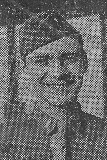
|
Haydon Awarded Direct Commission
A FOURTEENTH AIR FORCE BASE, CHINA - Charles Haydon of New York City has been given a direct commission as second lieutenant from the enlisted ranks, according to an announcement from the headquarters of the Fourteenth Air Force.
Formerly a sergeant assigned to the trial judge advocate's office at this "Flying Tiger" base, Lt. Haydon is continuing the same work as assistant to the trail judge advocate. He entered the Army at Fort Dix, New Jersey, in January, 1943, and has been in China since February, 1944.
A graduate of City College, New York, and St. John's College, New York, and with post-graduate courses at Columbia University and New York University. Lt. Haydon practiced law before coming into the Army.
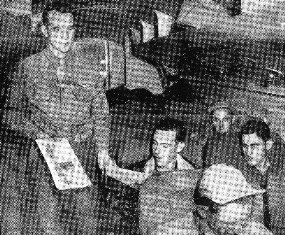 Pvt. R. Sweeney, flight clerk on the ATC plush-lined airliner, presenting passengers with a copy of The China Lantern before
departure. There is a reading lamp for every seat. (ATC photo)
Pvt. R. Sweeney, flight clerk on the ATC plush-lined airliner, presenting passengers with a copy of The China Lantern before
departure. There is a reading lamp for every seat. (ATC photo)
|
HQ., ATC CHINA WING, KUNMING - The first De Luxe Stateside C-47 Air Liner in China made its debut at this field last week, to innovate a new daily shuttle run.
The beautiful plush-lined passenger plane makes Chengtu its first stop, then heads for another base, departing immediately upon picking up additional passengers, for its final destination, a key ATC Base. Upon completion of this tour it returns the same evening via the same route in a total of six hours flying time.
This C-47, a recent arrival, was built in conformity with post-war planes, having such modernistic features as a reading lamp, soft reclining seats and ash trays. Hot coffee and K rations are served. An electric sign handled by the pilot flashes messages for buckling seat straps, no smoking, tighten parachute, and many others. The plane has all the conveniences of a commercial airline transport, with the exception of a hostess, who is supplanted by the flight record clerk.
Lt. Leonard Anderson, the assistant passenger officer, presented the ticket to the first passenger, Maj. D. G. Knight. Other passengers were Lt.-Col. S. C. Wang, Capt. S. E. Porter, Lt. R. Santay, M/Sgt. W. Hendrick, M/Sgt. D. Liebegolt, Sgt. R. Sheppard, Corp. A. Galvan and Corp. R. Betsher.
The crew for the initial trip:- Lt. William H. Butterfield, pilot, Lt. Carlton K. Schank, co-pilot, Corp. Richard W. Morrison, aerial engineer and Pvt. R. Sweeney, flight clerk.
Air-Ground Coordination Men Worked In Enemy Front Line
braving sleet-like rain storms in flimsy shelters and scooped cut slit trenches, existing on scanty Chinese rice rations, and exposed constantly to strafing attacks of Japanese planes, small air-ground co-ordination parties, operating practically in the enemy's front yard, were responsible in a large measure for the success of the recent Salween campaign.
At the opening of the northeast Burma campaign in May 1944, a small party of the 14th Air Force officers and men crossed the Salween River at Mangta Ferry and proceeded to Tantangtzu, a strongpoint of enemy resistance. There on a spot overlooking the Japanese positions they constructed the crude dugout and slit trenches that were to be their 'office' and 'home' for the coming weeks.
This small party consisting of eight men, among whom were Lt.-Col. Oscar R. Zipf, Freeport, Ill., officer in charge, T/Sgt.
|
It was the plan of Maj.-Gen. C. L. Chennault, commander of the 14th Air Force, that these field parties would be the key to air force operations in the Salween area, where enemy troops were widely dispersed over a protectively rugged terrain.
The plan first took form five months before the campaign began, when Gen. Chennault directed the establishment of a school for the training of Air Force personnel in methods and techniques. At the school both air force and ground personnel were briefly introduced to each others problems, and a definite technique established so that they might make their needs known to one another.
During the early operations the men who took part in the field work encountered many difficulties. Parties working in the Tatangtzu front, among them whom were S/Sgt. Edward T. Willet, Ebenezer, N.Y., Sgt. Azerie J. Michaud, Lisbon, Me., and T/Sgt. John H. Marshman, Frankfort Heights, Ill., found many technical 'bugs' that had to be worked out in the field in spite of adverse working conditions.
Relaying back information brought in by advance Chinese units and transmitting intelligence that they had been able to pick up through minute scrutinization of the Jap territory through field glasses, involved responsibility. The work done at this time helped to perfect the system for use in later engagement with the enemy.
Many men in the air parties operating through the earlier part of the campaign, including T/Sgt. Gene R. Chesko, Nanticoke, Pa., Sgt. John G. Flick, Clifton, N.J., and Sgt. Gordon L. Wood, St. Louis, Mo., were forced to exist for long periods of time on scanty diet of rice, supplemented by bamboo shoots and local vegetation. On one gala occasion they butchered and cooked a wild pig that they had hunted down in the forest battleground.
The fall of Tatangtzu, an almost impenetrable Japanese position, was due largely to the terrific pounding that the Jap positions received from American planes, and their operation was coordinated with Chinese ground troops throughout the entire attack by the air parties. Among those who served with the advance units were Sgt. Robert H. Earlywine, Dayton, Ohio and Sgt. Delmar Pegram, Chesapeake, W. Va.
|
When medium bombers blasted the walls of Tenchung into rubble, and thereby destroyed the city's invulnerability, air party men S/Sgt. Ralph J. Mehle, Reading, Pa., Sgt. Edward F. Roessler, Cincinnati, Ohio, and Sgt. Ted Freedman, Brooklyn, N.Y., were on the spot. Each of these three men had served since the beginning of the offensive and for their outstanding work were recently awarded the Bronze Star Medal.
It was during the Mangshih Valley offensive in the last half of the campaign that the air-ground coordination system came into its most effective phase. Much credit is due to the exceptional field work of Maj. John J. Pakula, Worcester, Mass., a former Infantry officer and his party of Lt. John A Sullivan, Memphis, Tenn., Sgt. William B. Palmer, Berwyn, Ill., and Sgt. Frank Green, Los Angeles, Cal.
This group arrived with the first armies that penetrated the mountains surrounding Mangshih Valley. They dug slit trenches at a high observation point not far from the enemy lines and there made a survey of the impending battleground.
Enemy troop movements, supply centers and heavily defended positions were reported. At Wing headquarters the messages from the field were received by day and night shifts of radio men, who relayed them to the intelligence and operations sections. Action in the air over Mangshih was planned from these reports.
A good share of the credit for the Salween victory has been given to the planes and pilots of the 14th Air Force - but without the work of these men of the air-ground coordination parties their mission could not have been nearly as effective.
|
Tops ATC Netmen
Showing surprisingly good form for an early-season match, the All-Base APO 627 tennis team won all three matches from the ATC racquet-men at the Base courts at APO 627 last week.
In the number one singles, Maj. Cyrus H. Polley, Buffalo, N.Y., 14th Air Force special service officer, upset ATC's Lt. David Price, former City College of New York player, in three sets 6-2, 5-7, and 6-3.
The majors' win came as a surprise, because, though he is nationally known as Canadian titlist and ranked in the top brackets in U.S. squash circles, this was the first public unveiling of his tennis prowess.
In the other singles match Maj. Charles P. Grant, Bloomfield, N.J., air base surgeon, toppled the ATC star, Maj. Robert D. Lawrence, former Univ. of Georgia netman, in three sets 6-1, 6-8, and 6-4.
The Base doubles combination of Maj. Polley and Capt. Mark Conn, base special service officer, Long Island, N.Y., beat the ATC tandem of Lt. Price and Lt. Frank Caplan, Albany, N.Y., in three sets. After dropping the first set 6-4, the Base team came back to win the next two 6-4 and 6-0 to sweep the match.
|
For All-China Cage Crown
Displaying their best passing form of the season and shooting with uncanny accuracy, the AACS Signals battered the Kunming Cagers 51-24, Sunday night at the Hangar at APO 627, before 1,500 fans that included four generals, to win the All-China basketball championship in the finals of the cage tourney held under the auspices of the Theater Special Service Office. In the opening game of the evening the Yankee All-Stars slaughtered the ATC Commandos 50-25 to take third place.
The Cagers were never in the game as, suffering from the loss of Ben Schall and Hubert Wolfe, both of whom injured their ankles in Saturday's semi-final game against ATC, they score only six baskets in the 40 minutes of play. The Signals never looked better as led by Bill Knapp, who scored 15 points, they picked cleverly to get in under for layups, and set up set shots outside the foul circle.
After opening cautiously and feeling out the Cagers man-to-man defense, the Signals picked up speed with Dick Hughes and Weyman Crawford cutting under the boards for layups, Mel Maceau tapping in a rebound under the basket and Art Hobson throwing in a long shot to dash out to an 18-4 lead at the end of the first period.
By halftime the Signals starting five had lengthened their lead to 28-9, as the Cagers, in what was probably their worse shooting form of the season, were only able to sink two buckets being constantly hurried in their shots by the aggressive Signals defense.
In the second half it was simply a case of playing out the time as the Signals put on a clever passing display, Willie Knapp began to hit with long shots from outside as the Cagers packed the defense and, when they rushed to break up the Signals monopoly of the ball, Art Hobson, Mel Maceau and Dick Hughes broke through for easy buckets.
Despite the runaway score the Cagers never gave up, pressing the Signals on the offense and making them work for every basket in spite of their big height advantage. Chapman and Joe Fruschione kept driving all the time, Fruschione netting six of the eight foul shots that he drew.
In the opening game for third place in the China ranking, the Yankee All-Stars had no trouble at all with the ATC Commandos. Using their height advantage to good effect, they effectively bottled up the Commandos with their zone defense and tallied repeatedly under the board to roll up a 23-11 halftime margin. Led by Leo Locher, who dumped seven buckets for 14 points, they won 50-25, while Elmer "Soup" Campbell with 10 points kept ATC in the scoring column.
In brief but impressive ceremonies after the game the "General Wedemeyer Trophy" was presented to the winners by Brig.-Gen. Douglas Weart, commanding general, Rear Echelon CT; the "General McClure Trophy" was awarded to the runners-up by Col. David Barnett, chief of staff, Chinese Combat Command, and souvenir banners were given to all the competing teams by Colonel Paul Myers, commanding officer of the Air Base and host for the tourney.
The "General Chennault Award" was presented by Maj.-Gen. C. L. Chennault, commanding general of the 14th Air Force, to Lt. Hubert Wolfe, Hastings, Neb., of the Kunming Cagers, as the "Outstanding Sportsman" of the tourney.
Sgt. William Knapp, Brooklyn, N.Y., was presented with the "General Cheves Award" by Major-Gen. G. X. Cheves, commanding general, SOS, as the "Outstanding Player" of the tourney for his work in leading the AACS Signals in the championship.
|
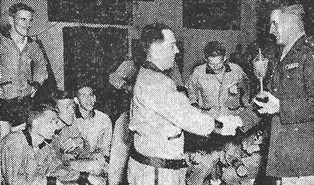
|
|
LEFT: Corp. Weyman Crawford, AACS Signals, beats Sgt. 'Ace' Chapman, Kunming Cagers, to the tap in the second quarter of the All-China cage championship game at the Hangar, APO 627, Sunday night, and directs it toward S/Sgt. Dick Hughes, his teammate. Behind the jumpers S/Sgt. Mel Maceau watches the ball, while on the right S/Sgt. Art Hobson and Sgt. Bill Knapp get ready in case the ball comes their way. Pfc. John Aldrich is the referee. (CENTER): Brig.-Gen. Douglas Weart, commanding general, Rear Echelon, present the "General Wedemeyer Trophy," emblematic of the All-China basketball championship, to Lt. James Smith, coach of the tourney winning AACS Signals, in a short ceremony after the games Sunday night, while the rest of the members of the team look on. (RIGHT): Lt. James I. Smith, coach of the AACS Signals, who won the All-China Basketball Championship by beating the Kunming Cagers in the finale of the four-day tourney, gives out with that victory smile as the rest of the team members crowd around. The players are, left to right: Corp. Weyman Crawford, Sgt. Buill Knapp, Sgt. Merve King, S/Sgt. Mel Maceau, Corp. Bill Papapetru, S/Sgt. Dick Hughes, and S/Sgt. Art Hobson. In the rear are S/Sgt. John McNally and S/Sgt. A. DeFalco (Signal Corps photos).
|
|
Banner Presented
By Chinese Women
HQ., 14TH AIR FORCE - "I look forward to continuing shoulder to shoulder with China until the enemy is driven from your land," Maj.-Gen. C. L. Chennault, commanding general of the Fourteenth Air Force, told a delegation of the Chinese National Women's Association for War Relief, who called at his headquarters recently to present banners.
Presentation of the banners to both Gen. Chennault and to Col. Clarence P. Talbot, commanding officer of the China Air Service Command, was made for the delegation by Madame Ho Ying Chin. Madame Ho is the wife of Gen. Ho, who is general chief of staff of the Chinese Army and supreme commander of the Chinese Supreme Army.
Assisting Madame Ho in the presentation were Miss Priscilla Huang, Mrs. William C. Wang, Mrs. Thomas Chao, Miss Tong Kow Ching and Miss Chang Chin. Brig.-Gen. Albert F. Hegenberger, chief of staff of the Fourteenth Air Force, assisted Gen. Chennault and Col. Talbot in the acceptance of the banners.
The delegation, of which Madame Ho is the chairman, is on a tour of the Burma-Yunan front looking into matters concerning the morale and welfare of Chinese and Allied troops. The Chinese National Women's Association for War Relief, of which the six ladies were representatives, is directed by Madame Chiang Kai-shek and was organized eight years ago in Nanking. It has as its objective, aid to service men and their families and offers assistance and training in factories and hospitals.
Madame Ho in presenting the banners to Gen. Chennault and Col. Talbot said, "On behalf of the Chinese National Women's Association for War Relief under the direction of Madame Chiang Kai-shek, we are today to present banners to the officers of the American Army Fourteenth Air Force as an expression of our deep appreciation for what you have done for China."
In his reply thanking the delegation of ladies, Gen. Chennault commented that he was mindful of the fact that women are always the mothers to a nation and complimented them upon their welfare work with the troops.

|
HQ., WEST CHINA RAIDERS - "Judging from the number of holes we see around this place, we ought to call our shop a doughnut factory," cracked S/Sgt. Frank Modzelewski, Pittsburgh, Pa. He was explaining his job as chief of the sheet metal shop in the maintenance department of the Yellow Scorpions fighter squadron.
The Scorpions, currently operating in China with the Raiders of Brig.-Gen. Russell E. Randall, have long been providing the Japs with some of the deadliest aerial opposition they've encountered throughout the IB and China Theaters. Although they inevitably come out on top in their engagements with the Nips the Scorpions admittedly don't come out of their numerous battles unscathed.
It's up to S/Sgt. Modzelewski and his two assistants, Sgt. Norman E. Butler, Allenton, R.I. and Sgt. Harry A. Bower, Sunbury, Pa., to mend the holes, rips and tears caused by the enemy.
"Most of our trouble comes from small arms fire," Modzelewski says. "When our planes go over a target those Japs poke their rifles out of their holes and just peck away. Once in a while they hit - and it's usually in the darnedest place.
"Sometimes you need a midget or a contortionist to get at the pesty holes caused by the rifle shots. Either that or you have to take the plane half-apart."
Not all of the Sergeant's work is of the merely "pesty" variety however. Modzelewski revealed that on one or two occasions the men had to practically rebuild a plane to put it in action against the Japs again.
"Our worst case happened when one of our pilots had a Jap bomber explode directly beneath him while he was on a strafing pass. When he brought the plane back to our base it all but collapsed on the runway. We helped repair it, though, and when the pilot stepped into the same cockpit a couple of weeks later, he couldn't believe it was the same plane."
Modzelewski recalled another plane that was towed into the sheet metal shack with "something like 230 holes in it."
"It was parked too close to a frag bomb during an enemy air raid at our base," the Sergeant said. "We patched that one up too, and today it's still making big holes in Jap planes and locomotives.
Sgt. Modzelewski complained that the biggest difficulty in trying to maintain a sheet metal shop in China is caused by the shortage of necessary tools and equipment. "When we first set up shop at our advanced base we ran into difficulty by not having all the tools we needed," he said. "We managed to make a few of the more important ones ourselves, though, and now I think we can take care of anything the Japs can dish out in the way of holes."
|
1340TH AAF BASE UNIT, CHINA - It's only occasional that a spot news publicity story is dropped in a Public Relations officer's lap but such was the case one recent Sunday afternoon when Sgt. Lewis A. Johnson of this unit casually mentioned that he heard that his brother, whom he hadn't seen for 15 years, was stationed less than twenty miles away.
Immediately it came to everyones mind a happy reunion for the Sgt. with his brother and get the first pictures - even to the extent of loading him in a jeep and rushing him to his brother. The deal was getting pretty good and a phone call was put through to the nearby base to verify the arrangements.
As yet no one concerned knows whether to feel a little disappointed or happy since after much shouting into the phone and checking records at the other end of the line, it was finally established that Sgt. Johnson's brother, Harry, had left for Stateside, which of course, from his point of view is good but otherwise PRO missed out on performing a Chaplains Mission as well as getting a good story.
AIR FORCE SERGEANT CHINA ‘ROLLING’ CHAMP
AIR BASE, APO 627 - Back home in New Albany, Pa., little Harold Bleiler use to wow 'em at grammar and high school spelling bees. He always won. And at the Fourth of July pie-eating contests Harold Bleiler was always first.
Somehow Harold lost his contest-winning habits when he got in the Army. He's now a sergeant, working at this base headquarters. Last week he miraculously regained his old form. One night he won a cigarette-rolling contest, in 12 seconds flat, during the opening celebration of the new squadron dayroom.
Sunday night, April 1, he and his partner won the first prize in the square dance contest of the first base barn dance. With his old confidence regained, Sgt. Bleiler is wishing discharges would be drawn by lottery.
|
|
CHINESE COMBAT COMMAND - Receipt of orders promoting 14 Chinese Combat Command majors to lieutenant colonel has been announced by Maj.-Gen. R. B. McClure, commanding general, CCC.
Officers who were promoted by the order, all of whom are serving in the field, are as follows:
Horace E. Belsher, Houston, Tex.; George V. Campbell, Stockton, Calif.; Newton L. Chamberlain, Grand Rapids, Mich.; Victor Duch, Lansing, Mich.; Ralph H. Frank, Pittsburgh, Pa.' Willard M. Gentry, Gering, Neb.; Thomas G. Maris, Jr., Atascadero, calif.; Frank W. Newell, Marion, Ind.; Benjamin M. Prestholt, Clarendon Hills, Ill.; Quentin S. Qigley, College Park, Ga.; Russell R. Reed, Harrisburg, Ill.; Loran L. Stewart, Lakeview, Ore.; Douglas C. Tomkies, Huntington, W.Va., and Reber M. Van Matre, San Antonio, Tex.
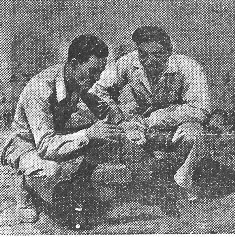 PFC. BELTRAN C. HUBBARD explains to a Chinese GI the art of opening locks without benefit of keys. Hubbard, who opened the front door of the Bank
of America in 30 seconds, is an entertainer with Unit 6 ATC Special Service show. A native of San Diego, Cal., where he performed his great lock fete,
Hubbard claims to be able to completely memorize an entire edition of any Saturday Evening Post within an hour-and-a-half.
PFC. BELTRAN C. HUBBARD explains to a Chinese GI the art of opening locks without benefit of keys. Hubbard, who opened the front door of the Bank
of America in 30 seconds, is an entertainer with Unit 6 ATC Special Service show. A native of San Diego, Cal., where he performed his great lock fete,
Hubbard claims to be able to completely memorize an entire edition of any Saturday Evening Post within an hour-and-a-half.
|
| G. I. Shakespeare In China . . . . . . . |
|
Cokes and hot dogs - mustard oozing Scotch and sodas piled up high Thru sizzling steaks their teeth will ply When they get home! O pickles sour and sweet in turn To taste a ham, again to learn And with such dangerous thoughts they fool And all the while they sit and drool For one who just from Stateside came I wonder at this silly game For the food above which they do yarn Is sure to give a grand heartburn! I see no change in their predicament I find no hope in their commitment It appears to me that they aspire From the frying pan into the fire On looking back at what I've written I've become weak as a kitten To my dismay and woe I've found - Twenty months and I'm Homeward Bound!!! |
|
Is to listen to those Rotation-bound In sweating out a month or two We have to listen to what they'll do When they get home! Like the man who has a little lirt Their's is larger they persist And on the pages they've included Things they promise they will dood-it When they get home! You'd know that ice cream leads the rest With chocolate cake the second best Closely followed by milk - and say! Not Grade "B" - but pure Grade "A"! When they get home! Then plums and a cherries, in that order To make a fruity salad - sorta (I've left out Orange and with good reason To find a rhyme would take a season) Even when they get home! |
|
PRIORITIES AND TRAFFIC MEETING IN KUNMING
1350TH BU, KUNMING - Methods of handling Revenue Traffic and a drive to improve quality service, highlighted the two-day conference of China Base Priorities and Traffic Directors held in Kunming recently.
Operations for the charging, by means of cash and Lend-Lease credit, were set up for standardized execution throughout the China Wing, ATC. From now on the ICD plays a dual role: that of hauling vital U.S. military war material and personnel and extra-military and allied government cargo and personnel on a pay basis.
According to Maj. D. A. Macgregor, division revenue traffic officer, a large percentage of supply, hitherto carried on a "free" basis for allied nations will now be carried on a lend-lease arrangement.
Quality service was an important feature on the meeting agenda. This will pertain not only to the handling and treatment of passengers, GI as well as officers, but to the contacting and servicing of shippers and consignees as well.
Coincidental with quality service, plans were discussed for the procurement and operation of GI vehicles utilized in the loading and off-loading of "Hump" and China-based aircraft.
Methods of improved and safer loading and tie-down were explained. Various sections of base level staff activities were discussed and their functions, insofar as they pertained to priorities and traffic. Co-operation between operations P & T, area control, and traffic control and S & S and maintenance were stressed.
An explanation of the current civil and political situation within the China area directly served by ICD-ATC was given by Col. M. E. Sheehan, GSC, SOS who is the director for the U.S. Army Ground Forces, of Civil Affairs. Col. Sheehan described the gradual influx of coastal Chinese civilians with the additional arrival of USAAF and ground force personnel.
Officers attending the two-day session were as follows:-
Capt. C. J. Loupassakis, 1339th, Maj. L. D. Schwartz, 1340th, Lt. C. C. Stewart, 1341st, Capt. G. M. Boedekr, 1342nd, Capt. N. P. Green, 1343rd, Capt. S. B. Joseph 1344th, Capt. J. H. Brust, 1338th AAFBU's, Lt. H. E. Pentler, C.O., ATC detachment.
|
HQ., WEST CHINA RAIDERS - The general's snuff bottles he'll have you know, are not to be sniffed at. They're to be admired because they comprise one of the finest American-owned collections of Chinese art.
Owner of the colorful assortment of Chinese snuff bottles is Brig.-Gen. Russell E. Randall, commander of the West China Raiders. Himself an ardent admirer of Chinese art, Gen. Randall turned collector in a wholesale-way soon after his arrival in China when he purchased a display of more than four hundred of the tiny art curios from one of China's museums.
Frequent excursions into Cathay's curio marts expanded the collection until now the General's many-hued and multi-shaped array of Chinese art in miniature numbers well over five hundred. In all they make up a representative sampling of one of the most lively and interesting expressions of Oriental art.
According to Gen. Randall, who devotes much of his out-of-combat time to the study of Chinese culture, the creation of snuff bottles constitutes a latter-day phase of Chinese art. Most of the bottles to be found today originated in the eighteenth and nineteenth centuries.
Tobacco, Gen. Randall pointed out, was unknown in China until sometime during the seventeenth century when it was imported into the Orient by European missionaries. A century later, however, the taking of snuff had become a countrywide habit.
The first snuff bottles were prosaic in composition and utilitarian in design - mere tobacco containers, fitted with tight stoppers to which was attached a small spoon to remove the tobacco. They were carried in the sleeve or belt of the user.
When the use of tobacco became fashionable in the imperial courts during the Ch'ing dynasty the snuff bottle made its debut as an "object d'art." Competition among the royal and wealthy classes of China stimulated craftsmen of the period to exert their utmost skill in creating out-of-the-ordinary and artistic pieces. The eventual result was that snuff bottles became characterized by the endless variety of material and design which went into their making.
Some of the specimens in Gen. Randall's collection for example, are made of simple substances like wood, porcelain, glass and bamboo, while others are semi-precious creation of jade, amethyst, turquoise, carnelian and onyx.
The designs and decorations on snuff bottles also vary infinitely. Flowers, animals and rural scenes are among the most common of the exquisite carvings to be found on the exterior of the bottles. The most unusual and attractive, perhaps, are the glass bottles which have been painted from the interior. The brushwork in these remarkable pieces - executed entirely through the narrow opening of each bottle truly illustrates the skill and patience of Chinese artists.
|
GI Contributed Funds
Distributed In China
KUNMING - Eight missionary and benevolent enterprises in this area are sharing in the April distribution of funds contributed by GI's and officers at Protestant services at Hostels 5, 3 and 7, it was announced by Chaplain (Capt.) Mert M. Lamson of SOS.
Allocations include $75 to British Methodists, $80 to Anglicans, $20 to Presbyterian Mission, $20 to Church of Christ in China, $40,000 CN to En Kwang school, $40,000 CN to China Inland Mission, $50,000 CN to Lutheran Mission, $10,000 CN for Yunnan Deaf and Blind school.
There is $25 set up for miscellaneous needs and a balance in the treasury for emergencies, the Chaplain reported.
American Univ. Club,
Meeting In Kunming
KUNMING - The bimonthly meeting of the American University Club of Kunming scheduled for the Theater at Hostel 1 at 2 p.m. Sunday, April 15, will be the first with a definite cultural program according to announcement of G. D. Su, chairman of the general affairs committee.
It is expected that nearly 500 graduates or former students of colleges and universities in the United States will be present. All are welcome. Previous meetings have shown about half of the attendance to be GI's and Officers of U.S. Forces in the area and half Chinese men and women who have gone overseas to America for schooling.
T. L. Tseng, (MIT) professor of chemistry at Southwestern Associated Universities, will speak briefly on "Industrialization of China."
Wu Chi-yuen, professor of economics at the same university, will answer questions in his field.
Y. T. Miao (Minnesota) president of the club, member of the Yunnan Provincial government council, will preside at the meeting.
Plans are to have the meeting begin promptly at 2 p.m. with tea served at 4 p.m. The China Theater Band will play for the fellowship and entertainment program.
Kwei Chu Hui Elects
Officers, Committeemen
KUNMING - More than 50 Master Masons, officers of various units in the area, were present at the April meeting of the Kwei Chu Hui, social and charitable club, in the Red Cross Town Club last week.
A brief constitution was adopted.
In conformity with the new regulations, two additional officers were elected and five named members of the executive committee. Col. Archibald D. Fisken, antiaircraft officer, is president of the Club and Maj.-Gen. C. L. Chennault is honorary president.
New officers are Col. Edward C. Reber, Norristown, Pa., vice president in charge of programs, and Lt.-Col. Kenneth D. Willoughby, Farminton, Mo., secretary-treasurer.
Members of the executive committee include Col. Donald Q. Harris, Chicago, FATC Maj. John Q. Timbrel, Bloomsburg, Pa., SOS; Lt. Oswald W. Wagner, Denver, Colo., RE; Col. Lawrence M. Scarborough, Norfolk, Va. CCC; and Lt.-Col. John M. Williams, Albany Ind., AC.

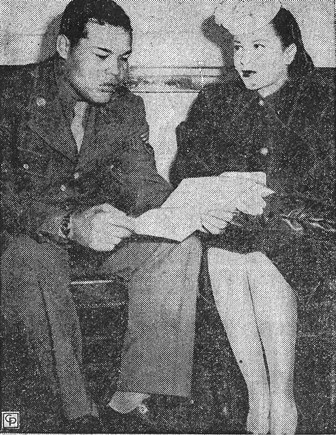 SGT. JOE LOUIS, the world's heavyweight boxing champion, is pictured with his wife in a Chicago courtroom after Mrs. Louis had been granted
a divorce from the ring king on charges of desertion. Mrs. Louis was awarded custody of their two-year-old daughter for 10 months of the year.
SGT. JOE LOUIS, the world's heavyweight boxing champion, is pictured with his wife in a Chicago courtroom after Mrs. Louis had been granted
a divorce from the ring king on charges of desertion. Mrs. Louis was awarded custody of their two-year-old daughter for 10 months of the year.
|
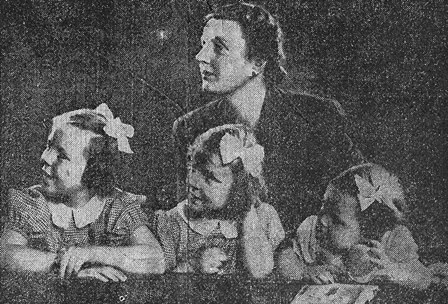 RETURN FROM EXILE - Princess Juliana of the Netherlands with her three daughters, Princesses Beatrix, Irene and Margaret have returned to their
liberated country. Queen Wilhelmina, first of exiled monarchs to return, was greeted joyously by her subjects when she toured Holland.
RETURN FROM EXILE - Princess Juliana of the Netherlands with her three daughters, Princesses Beatrix, Irene and Margaret have returned to their
liberated country. Queen Wilhelmina, first of exiled monarchs to return, was greeted joyously by her subjects when she toured Holland.
|
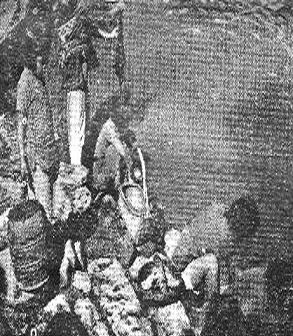 WEEKLY WASHDAY on a canal that runs through Kunming. The entire family, mother and daughters, do the washing, while baby overlooks the proceedings
from his perch on mother's back. (Signal Corps photo).
WEEKLY WASHDAY on a canal that runs through Kunming. The entire family, mother and daughters, do the washing, while baby overlooks the proceedings
from his perch on mother's back. (Signal Corps photo).
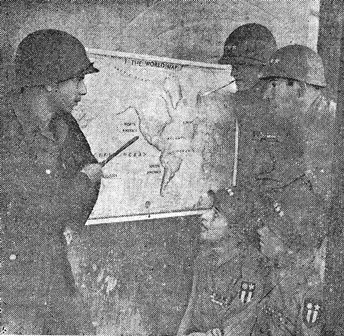 BASHA BRIGADIERS - Four "5 star generals" take orders on the tactical situation from a private at the 1350th AAF-BU in Kunming but it's all in fun
as part of the routine of ATC's Special Service show which recently completed a successful run in China. Pvt. Stanley Hamilton, Wichita, Kan., does the
pointing and looking on left to right are "generals" Ray Paralta, Los Angeles, Cal., Ray Gray, Hollywood, Cal., Alfred Tellinghuisen, Hampton Isle and
Joe Beaudoin, Brunswick, Maine. (ATC photo).
BASHA BRIGADIERS - Four "5 star generals" take orders on the tactical situation from a private at the 1350th AAF-BU in Kunming but it's all in fun
as part of the routine of ATC's Special Service show which recently completed a successful run in China. Pvt. Stanley Hamilton, Wichita, Kan., does the
pointing and looking on left to right are "generals" Ray Paralta, Los Angeles, Cal., Ray Gray, Hollywood, Cal., Alfred Tellinghuisen, Hampton Isle and
Joe Beaudoin, Brunswick, Maine. (ATC photo).
|
 CINCINNATIANS - Capt. Edward J. Herrnstein, right, and T/Sgt. Lewis G. Kallmeyer, left, tell each other that the Buckeye state was never like this
as they tour the Temple of the Thousand Gods in China. Lt. Barbara Cornary of the 95th Station Hospital, who may never have seen Ohio, looks as if she's
inclined to agree.
CINCINNATIANS - Capt. Edward J. Herrnstein, right, and T/Sgt. Lewis G. Kallmeyer, left, tell each other that the Buckeye state was never like this
as they tour the Temple of the Thousand Gods in China. Lt. Barbara Cornary of the 95th Station Hospital, who may never have seen Ohio, looks as if she's
inclined to agree.
 LESS OIL FOR THE ENEMY - An oil tank on Japanese-occupied Bukum Island, near Singapore, still burns many hours after B-29 Superfortress of Brig.-Gen.
Roger M. Ramey's XXth Bomber Command hit the vital target from bases in India.
LESS OIL FOR THE ENEMY - An oil tank on Japanese-occupied Bukum Island, near Singapore, still burns many hours after B-29 Superfortress of Brig.-Gen.
Roger M. Ramey's XXth Bomber Command hit the vital target from bases in India.
|
 YANKEE HUMOR - After battling their way into Trier, two 3rd Army men still have enough energy left to stage impromptu act for buddies. With stovepipe
hats, wigs and bicycle built for two, they pedal through streets in "Gay Nineties" manner. Sgt. James V. Shiffer of Elizabethtown, Pa., is at handlebars
with Sgt. Joseph Ignozzi of New Kensington, Pa., behind.
YANKEE HUMOR - After battling their way into Trier, two 3rd Army men still have enough energy left to stage impromptu act for buddies. With stovepipe
hats, wigs and bicycle built for two, they pedal through streets in "Gay Nineties" manner. Sgt. James V. Shiffer of Elizabethtown, Pa., is at handlebars
with Sgt. Joseph Ignozzi of New Kensington, Pa., behind.
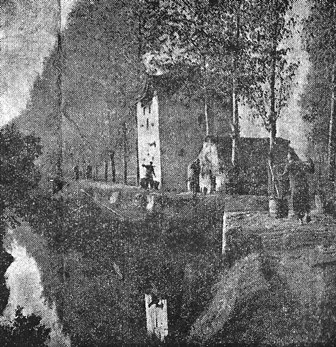 FAMILIAR SIGHT early every morning are these coolies who trot along the banks of canals in China with buckets of "night soil," which they have collected
for use as fertilizer. (Signal Corps photo).
FAMILIAR SIGHT early every morning are these coolies who trot along the banks of canals in China with buckets of "night soil," which they have collected
for use as fertilizer. (Signal Corps photo).
|
The CHINA LANTERN is the newspaper for the United States Forces in the China Theatre and is published three times weekly by Lt. Lester H. Geiss, Editor-in-Chief, for military personnel only. Lt. Harry D. Purcell, Managing Editor; Lt. Maurice Pernod, Production Chief. Pfc. Richard P. Wilson, Reporter. Editorial offices: Hqrs., SOS China Theater, Kunming, China, and Hqrs., SOS, Calcutta, India. Printed by Ajit Kumar Sinha at the "Amrita Bazar Patrika" Press, Calcutta. Unless specifically stated, news and features appearing in the China Lantern do not necessarily represent the views of the War Department; the Commanding General, USF, CT, or any other official source.

APRIL 13, 1945
Adapted from the original issue of The China Lantern
Better quality image of Adele Mara used in this re-creation
Copyright © 2019 Carl Warren Weidenburner
TOP OF PAGE PRINT THIS PAGE ABOUT THIS PAGE
SEND COMMENTS CLOSE THIS WINDOW
 SIGNS OF THE TIMES - Gay Paree is becoming somewhat Americanized, according to these signs in the Place de E'Toile.
These very emphatic traffic warnings show a definite Yankee touch.
SIGNS OF THE TIMES - Gay Paree is becoming somewhat Americanized, according to these signs in the Place de E'Toile.
These very emphatic traffic warnings show a definite Yankee touch.
 OUR EAT YOUR HEART OUT DEPT. this week presents Adele Mara, Republic Pictures pretty, whose bathing suit looks as if it might have
been carved out of the upholstery of a famous New York night spot. In either place the stripes are relaxing.
OUR EAT YOUR HEART OUT DEPT. this week presents Adele Mara, Republic Pictures pretty, whose bathing suit looks as if it might have
been carved out of the upholstery of a famous New York night spot. In either place the stripes are relaxing.
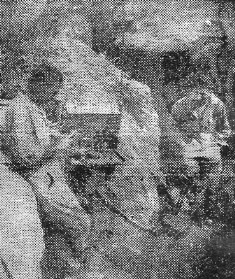 In a slit-trench close to enemy lines, Maj. John J. Pakuls, left, and Sgt. Edward Green, await the appearance of Fourteenth Air Force
planes during a battle of the Salween campaign.
In a slit-trench close to enemy lines, Maj. John J. Pakuls, left, and Sgt. Edward Green, await the appearance of Fourteenth Air Force
planes during a battle of the Salween campaign.
 Air-ground coordination men observing enemy troop concentration from their front line position. Maj. Pakula, right, stands beside the
radio while Sgt. Kenneth Wilson makes notes on the enemy's movements. The Chinese boy at the left acts as an interpreter-messenger.
Air-ground coordination men observing enemy troop concentration from their front line position. Maj. Pakula, right, stands beside the
radio while Sgt. Kenneth Wilson makes notes on the enemy's movements. The Chinese boy at the left acts as an interpreter-messenger.
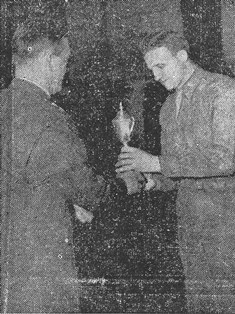
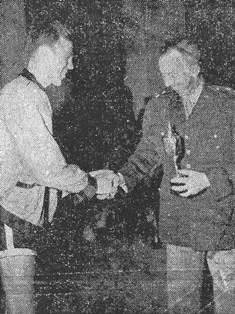 MAJOR-GEN. C. L. CHENNAULT PRESENTS (Left) Lt. Hubert Wolfe, Hastings, Neb., of the Kunming Cagers with the "General Chennault Award." emblematic of the "Outstanding Sportsman" of
the All-China basketball tourney. (Right) Maj.-Gen. G. X. Cheves, Comm.-Gen., SOS, congratulates Sgt. Bill Knapp, Brooklyn, N.Y., as he presents
him with the "General Cheves Award," emblematic of the "Outstanding Player." (Signal Corps photos).
MAJOR-GEN. C. L. CHENNAULT PRESENTS (Left) Lt. Hubert Wolfe, Hastings, Neb., of the Kunming Cagers with the "General Chennault Award." emblematic of the "Outstanding Sportsman" of
the All-China basketball tourney. (Right) Maj.-Gen. G. X. Cheves, Comm.-Gen., SOS, congratulates Sgt. Bill Knapp, Brooklyn, N.Y., as he presents
him with the "General Cheves Award," emblematic of the "Outstanding Player." (Signal Corps photos).

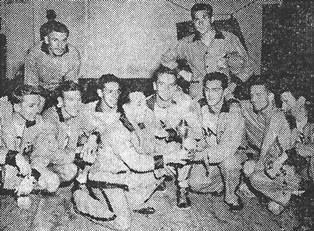
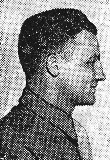
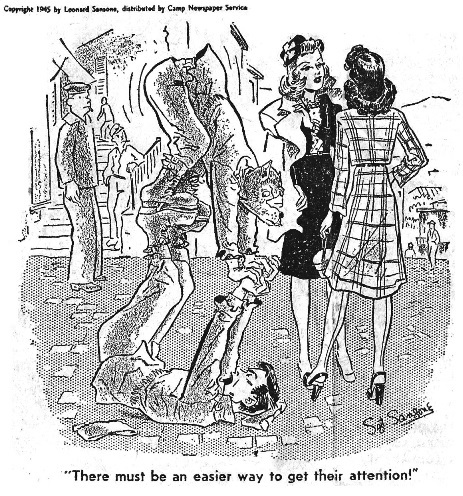
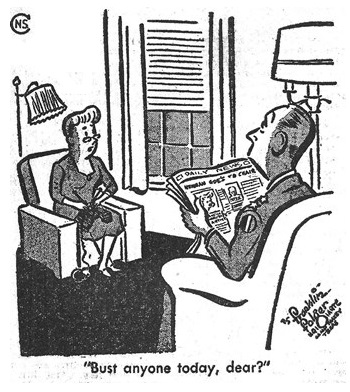
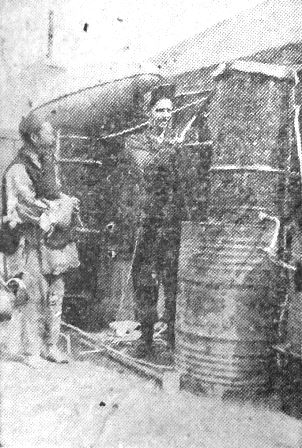 1339TH AAF-BU, CHINA - Taking advantage of an old belly tank and several oil drums, Sgt. Peter Cimesa, Gary, Ind., 1339th radio
operator, riggs himself up a Stateside hot water cistern which feeds right into his tent.
1339TH AAF-BU, CHINA - Taking advantage of an old belly tank and several oil drums, Sgt. Peter Cimesa, Gary, Ind., 1339th radio
operator, riggs himself up a Stateside hot water cistern which feeds right into his tent.

 PUPS ON A PROP hub of one of the huge C-54 'Skymaster' transports which fly the rock pile between China and India, obligingly posed
for this photo at the 1350th Base Unit, ATC, Kunming. (ATC photo).
PUPS ON A PROP hub of one of the huge C-54 'Skymaster' transports which fly the rock pile between China and India, obligingly posed
for this photo at the 1350th Base Unit, ATC, Kunming. (ATC photo).
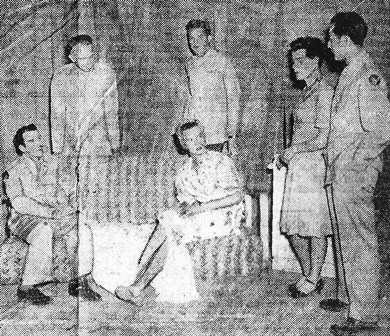 SCENE FROM THE PRODUCTION "OVER 21" shows, left to right, Sgt. Bill Brown as Roy Lupton; Sgt. Joseph Rheinhart, Monterey, cal., as Robert Drexel Gow; Corp. Bill Garret, Atlanta, Ga., as Jan Lupton;
Pfc. Jack Carey, Kingsford, Mich., as Col. H. C. Foley; Corp. Jack Jerome, Forest Hills, L.I. as Paula Wharton, and Pvt. Sol Bender, Los Angeles, Cal.,
as Max Wharton. (Air Force photo).
SCENE FROM THE PRODUCTION "OVER 21" shows, left to right, Sgt. Bill Brown as Roy Lupton; Sgt. Joseph Rheinhart, Monterey, cal., as Robert Drexel Gow; Corp. Bill Garret, Atlanta, Ga., as Jan Lupton;
Pfc. Jack Carey, Kingsford, Mich., as Col. H. C. Foley; Corp. Jack Jerome, Forest Hills, L.I. as Paula Wharton, and Pvt. Sol Bender, Los Angeles, Cal.,
as Max Wharton. (Air Force photo).